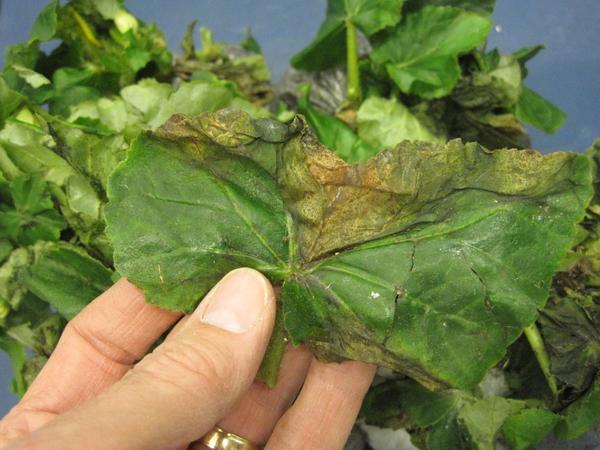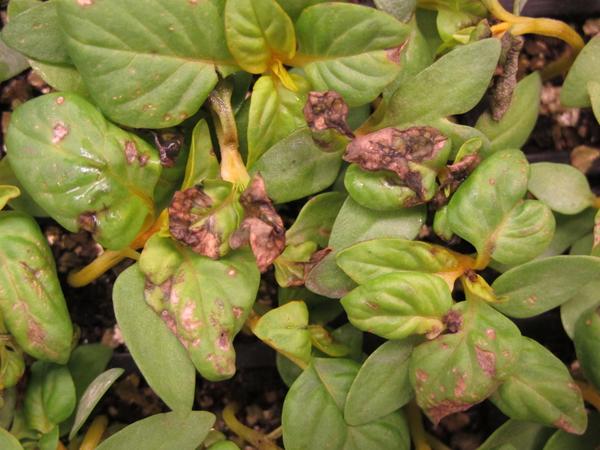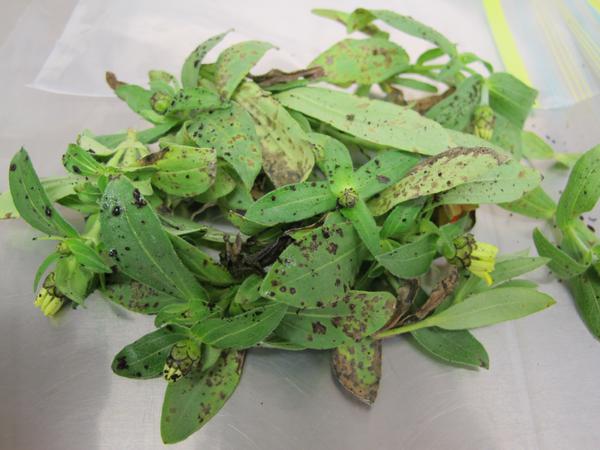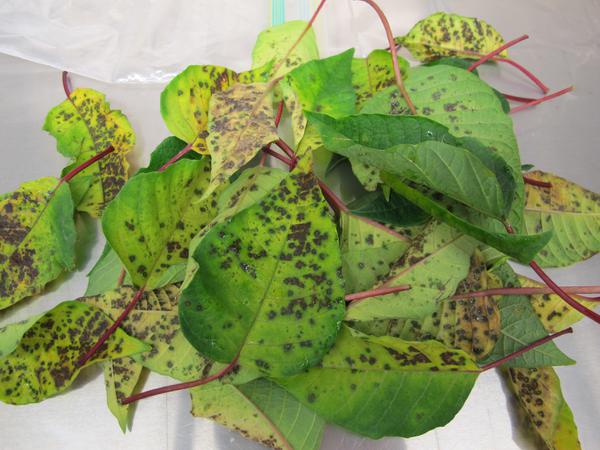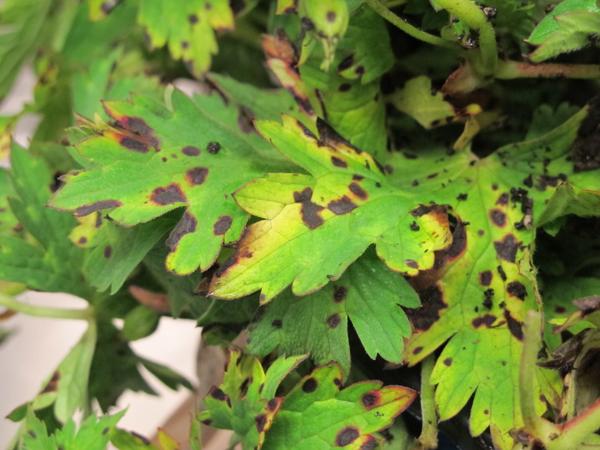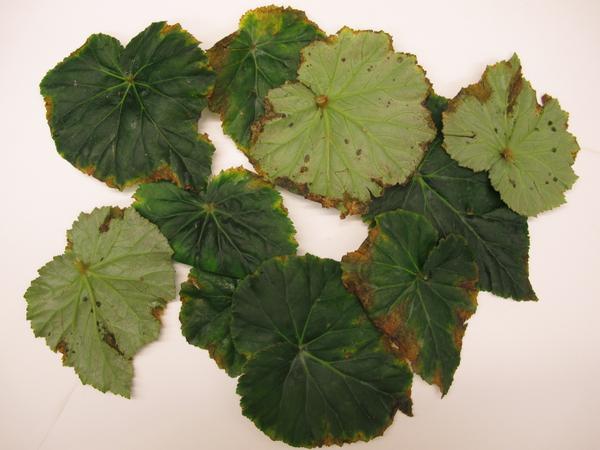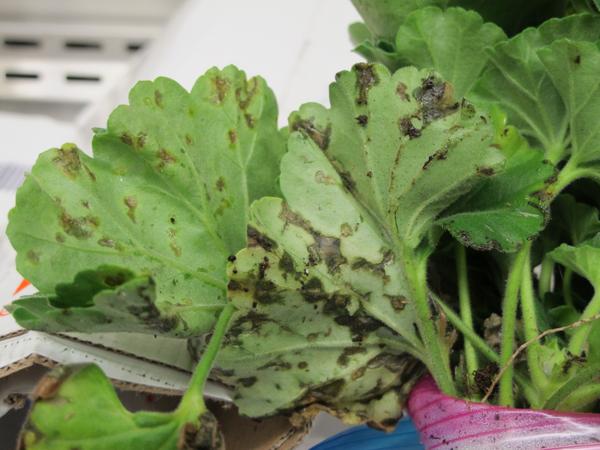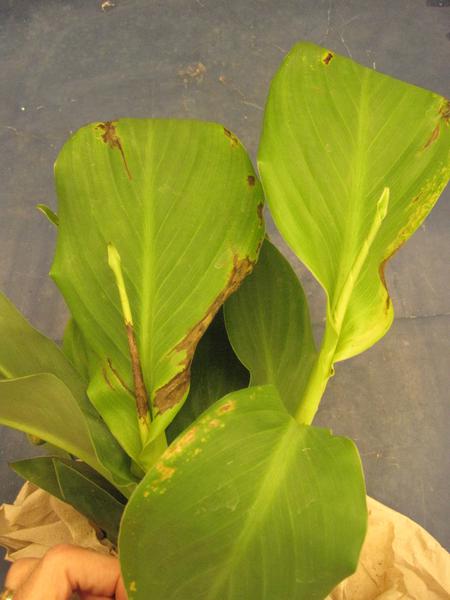Symptoms and Identification
Typical leaf spots caused by bacteria appear as water-soaked, brown to black lesions often outlined with a yellow halo. Water-soaked (or sometimes called greasy) spots often appear on the underside of the leaf first. Lesions caused by Xanthomonas on Begonia and Pelargonium are v-shaped, extending inwards from the leaf margin. Necrotic spots may be angular or somewhat round. Spots may coalesce to cause a blighted appearance in some hosts.
"Look alike" diseases: Many fungal leaf spots, depending on the host, can be confused with lesions caused by bacteria. There is no convenient way to distinguish between these two, especially for the layman. Lesions caused by bacteria may produce a visible stream of bacteria when placed in water and observed under magnification, but streaming may not always be observed if the bacterium is not active. Similarly, fungal spores may be observed if conditions have been conducive for sporulation, although the lack of spores does not eliminate a fungus as the cause. Therefore, it is best to get diseased plants diagnosed by a plant disease clinic.
Pathogen
Bacterial leaf spots on ornamental crops are typically caused by bacteria in the genera Pseudomonas, Xanthomonas, and Acidovorax. Some of these bacteria cause disease on a wide host range while others cause disease on specific plant genera. In general, species of Xanthomonas are most active under warm conditions (>80F), but the presence of cooler temperatures does not eliminate the possibility of a bacterial disease being present.
Hosts
A wide range of ornamental hosts are affected by bacterial leaf spot. Susceptible hosts include canna, begonia, marigold, tickseed, poinsettia, English ivy, geranium, chrysanthemum, petunia, vinca, salvia, zinnia, mandevilla, lavender, and gerber daisy.
Some of the more common bacterial leaf spots that occur on ornamentals include, but is not limited to, the following:
Bacterial leaf spot of zinnia is caused by Xanthomonas campestris pv. zinniae.
V-shaped lesions on geranium is caused by Xanthomonas axonopodis pv. begonia.
Bacterial leaf blight on cockscomb is caused by a species of Pseudomonas.
Bacterial leaf spot on canna lily is caused a species of Avidovorax.
Host Parts Affected
Symptoms occur on the leaves and, possibly, stems. Depending on the pathogen, flowers also may be affected. In some hosts, Xanthomonas can be systemic.
Disease Transmission
Seed transmission is a means of primary spread for some bacterial species.
Secondary spread, or local spread, can occur by water splashing during irrigation or rainfall events. Touching, moving, or otherwise handling plants when they are wet also allows the bacteria to spread.
Survival in crop debris depends on the species, but can allow the bacterium to carryover to the next crop.
Many (if not all) of the bacteria listed above can be trasmitted through seed, liners, or other propagation material.
Favorable Environmental Conditions
Warm, humid conditions are favorable for disease development. Optimum temperature range for disease development of Pseudomonas is 77°F to 86°F, althought some species thrive in cooler temperatures (P. syringae favors tempeartures of 55°F to 77°F), Xanthomonas is 77°F to 86°F, and Acidovorax is 80°F to 86°F. These conditions make disease management on propagated plants under mist in greenhouses particularly difficult.
General Disease Management
- If starting crop from seed, purchase certified disease-free seed only. Most reputable seed companies provide certified disease-free seed.
- If starting crop from cuttings or plugs, use healthy plant material only and avoid diseased material.
- Discard any diseased material and cleanse hands before proceeding with healthy material.
- Remove and destroy symptomatic plants and adjacent plants (to remove any asymptomatic, but infected plants) to avoid spreading the bacteria.
- Drip or ground irrigation can help prevent spread of the pathogen. Minimize the use of overhead irrigation to prevent disease, or water when leaves can dry rapidly.
- Leaves should be kept as dry as possible. Watering early or at a time of day that foliage can dry quickly will help prevent disease spread.
- Use preventative bactericides (see below) if there has been a history of disease. Apply prior to disease development.
- Sanitize greenhouse benches, tools, pots, flats and any other equipment by removing crop and soil debris entirely, followed by treatment with a sanitizer.
Disease Management for Conventional Growers
Sanitation is the most important and effective management tool for control of bacterial pathogens. Bactericides (listed below) will only provide preventative control, so it is important the products are applied before disease occurs. Growers that have had bacterial leaf spot in the past should consider using one or more of the products below. Note that some strains of some of the bacterial pathogens listed above may be resistant to copper products and/or streptomycin sulfate, so if loss of control is observed consider switching products. In general, spray on a 7-10 day schedule, but follow label instructions. Spraying more frequently will not reduce disease.
| Product | Active ingredient | Efficacy |
|---|---|---|
| (various) e.g., Champ, Nu-COP, CuPRO | copper hydroxide | Fair |
| Junction | copper hydroxide + mancozeb | Fair |
| Camelot O | copper octanoate | Fair |
| Cuprofix | copper sulfate | Fair |
| Phyton 27 or 35 | copper sulfate pentahydrate | Fair |
| Agri-Mycin | streptomycin sulfate | Fair |
| Alliette WDG, Areca | fosetyl-Al | Poor to fair |
| (various) e.g., K-Phite, Fosphite | mono- and di- potassium salts of phosphorous acid | Poor to fair |
Disease Control for Organic Growers
Sanitation is the most important and effective management tool for control of bacterial pathogens. Bactericides (listed below) will only provide preventative control and efficacy is variable, so it is important the products are applied before disease occurs. Growers that have had bacterial leaf spot in the past should consider using one or more of the products below. Note that some strains of some of the bacterial pathogens listed above may be resistant to copper products and/or streptomycin sulfate, so if loss of control is observed consider switching products. In general, spray on a 7-10 day schedule, but follow label instructions. Spraying more frequently will not reduce disease.
| Product | Active ingredient |
|---|---|
| Badge X2 | copper oxychloride + copper hydroxide |
| Camelot O | copper octanoate |
| Cease | Bacillus subtilis QST 713 strain |
| Cuproxat FL | basic copper sulfate |
| Kocide 2000-O | copper hydroxide |
| Regalia | extract of Reynoutria sachalinensis |
| Subtilex NG | Bacillus subtilis strain MBI 600 |
Disease Control for Homeowners
Home owners should follow the general disease management recommendations listed above. In addition, if few leaves are showing symptoms of bacterial leaf spot, a homeowner can remove those leaves (when they are dry) to reduce the level of infection. Dispose of leaves in the landfill or deep bury them. Also, copper-based fungicides are available at garden stores and can be used preventatively, but, as noted above, efficacy can be variable.
Additional Resources
North Carolina Agricultural Chemicals Manual
NC State University Plant Disease and Insect Clinic
Southeastern US Pest Control Guide for Nursery Crops and Landscape Plantings
2019 Update: Bacterial Leaf Spots and Blight (GPN Magazine article)
Acknowledgements
This disease factsheet was prepared by the Meadows Plant Pathology Lab.
Funding for updating this fact sheet comes from the United States Department of Agriculture (USDA)-National Instiute of Food and Agriculture (NIFA) (2017-70006-27141).
Thank you to Mike Munster, NC State Plant Disease and Insect Clinic, for kindly reviewing and improving this disease factsheet.
Publication date: Jan. 14, 2019
Reviewed/Revised: May 4, 2020
N.C. Cooperative Extension prohibits discrimination and harassment regardless of age, color, disability, family and marital status, gender identity, national origin, political beliefs, race, religion, sex (including pregnancy), sexual orientation and veteran status.
Recommendations for the use of agricultural chemicals are included in this publication as a convenience to the reader. The use of brand names and any mention or listing of commercial products or services in this publication does not imply endorsement by NC State University or N.C. A&T State University nor discrimination against similar products or services not mentioned. Individuals who use agricultural chemicals are responsible for ensuring that the intended use complies with current regulations and conforms to the product label. Be sure to obtain current information about usage regulations and examine a current product label before applying any chemical. For assistance, contact your local N.C. Cooperative Extension county center.
N.C. Cooperative Extension prohibits discrimination and harassment regardless of age, color, disability, family and marital status, gender identity, national origin, political beliefs, race, religion, sex (including pregnancy), sexual orientation and veteran status.

